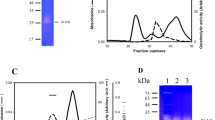Abstract
Objective
Thrombin appears to underlie myometrial contractions in response to intrauterine bleeding. In a similar fashion, thrombin generated within the uterus in the absence of active bleeding could also produce contractions. These studies sought to determine whether functionally active prothrombin is expressed in the pregnant and nonpregnant rat uterus.
Methods
Uteri were obtained from proestrus/estrus and timed-pregnant Sprague-Dawley rats. Western blots were performed using antithrombin antibodies. Immunohistochemical studies were performed using the same antibodies along with the Vector Elite ABC kit. Qualitative reverse transcriptaase—polymerase chain reaction studies were performed using rat prothrombin-specific oligonucleotide primers. In vitro uterine contraction studies were performed using Taipan snake venom (an exogenous prothrombinase) and components of the plasma prothrombinase complex (Factors Xa and V) with and without pretreatment with thrombin inhibitors (heparin or hirudin).
Results
The Western blots demonstrated prothrombin peptides in myometrial tissue from estrus and pregnant rats. The immunohistochemical studies confirmed prothrombin peptides in both the circular and longitudinal myometrium, along with the endometrium. The reverse transcriptase—polymerase chain reaction studies demonstrated prothrombin mRNA in the endometrium and placenta, but not in the myometrial smooth muscle. The Taipan snake venom stimulated a significant increase in contractions, which were suppressed by pretreatment within heparin and hirudin. The Factor Xa and V complex also significantly stimulated uterine contractions, which were likewise inhibited by hirudin.
Conclusion
These studies provide evidence supporting the expression of functionally active prothrombin in the pregnant and nonpregnant rat uterus. Based on the presence of its mRNA, prothrombin appears to be synthesized in the endometrium and placenta; in contrast, the myometrial smooth-muscle cells appear to sequester preformed prothrombin. These results support the hypothesis that intrauterine thrombin could play an autocrine/paracrine role in the regulation of contractile activity.
Similar content being viewed by others
References
Grand RJ, Turnell AS, Grabham PW. Cellular consequences of thrombin-receptor activation. Biochem J 1996;313:353–68.
Bohm SK, McConalogue K, Kong W, Bunnett NW. Proteinase-activated receptors: New functions for old enzymes. News Physiol Sci 1998;13:231–40.
Dery O, Corvera CU, Steinhoff M, Bunnett NW. Proteinase-activated receptors: Novel mechanisms of signaling by serine proteases. Am J Physiol 1998;274:C1429–52.
Kahn ML, Hammes SR, Botka C, Coughlin SR. Gene and locus structure and chromosomal localization of the protease-activated receptor gene family. J Biol Chem 1998;273:23290–6.
Phillippe M, Kim T, Bieber E. Protease activated receptor (PAR) isoform expression in myometrial tissue obtained from estrus and timed-pregnant rats. J Soc Gynecol Investig 2000;7(Suppl):132A.
Elovitz MA, Ascher-Landsberg J, Saunders T, Phillippe M. The mechanisms underlying the stimulatory effects of thrombin on myometrial smooth muscle. Am J Obstet Gynecol 2000;183:674–81.
Elovitz MA, Saunders T, Ascher-Landsberg J, Phillippe M. The effects of thrombin on myometrial contractions in vitro and in vivo. Am J Obstet Gynecol 2000;183:799–804.
Jamison CS, Degen SJF. Prenatal and postnatal expression of mRNA coding for rat prothrombin. Biochim Biophys Acta 1991;1088:208–16.
Henrikson KP, Jazin EE, Greenwood JA, Dickerman HW. Prothrombin levels are increased in the estrogen-treated immature rat uterus. Endocrinology 1990;126:167–75.
Henrikson KP, Hall ES, Lin Y. Cellular localization of tissue factor and prothrombin in the estrogen-treated immature rat uterus. Biol Reprod 1994;50:1145–50.
Arena CS, Quirk SM, Zhang YQ, Henrikson KP. Rat uterine stromal cells: Thrombin receptor and growth stimulation by thrombin. Endocrinology 1996;137:3744–9.
McBane RD, Miller RS, Hassinger NL, Chesebro JH, Nemerson Y, Owen WG. Tissue prothrombin. Arteriosclerosis Thromb Vase Biol 1997;17:2430–6.
Owen WG, Jackson CM. Activation of prothrombin with Oxyuranus scutellatus scutellatus (Taipan snake) venom. Thrombosis Res 1973;3:705–14.
Kim TT, Saunders T, Bieber E, Phillippe M. Tissue specific protein kinase C (PKC) isoform expression in rat uterine tissue. J Soc Gynecol Investig 1999;6:293–300.
Rychlik DF, Bieber E, Phillippe M. Constitutive androstane receptor (CAR) expression in the rat cervix during gestation. J Soc Gynecol Investig 2000;7:355–7.
Grover PK, Dogra SC, Davidson BP, Stapleton AMF, Ryall RL. The prothrombin gene is expressed in the rat kidney. Implications for urolithiasis research. Eur J Biochem 2000;267:61–7.
Benzakour O, Kanthou C, Lupu F, Dennehy U, Goodwin C, Scully MF, et al. Prothrombin cleavage by human vascular smooth muscle cells: A potential alternative pathway to the coagulation cascade. J Cell Biochem 1995;59:514–28.
Shintani Y, Hirano K, Nishimura J, Nakano H, Kanaide H. Enhanced contractile response to thrombin in the pregnant rat myometrium. J Pharmacol 2000;131:1619–28.
Clark DA, Ding JW, Chaouat G, Coulam CB, August C, Levy GA. The emerging role of immunoregulation of fibrinogen-related procoagulant Fgl2 in the success or spontaneous abortion of early pregnancy in mice and humans. Am J Reprod Immunol 1999;42:37–43.
Levy GA, Liu M, Ding J, Yuwaraj S, Leibowitz J, Marsden PA, et al. Molecular and functional analysis of the human prothrom-binase gene (HFGL2) and its role in viral hepatitis. Am J Pathol 2000;156:1217–25.
Rychlik D, Chien E, Phillippe M. Prothrombinase expression in the pregnant rat uterus. Am J Obstet Gynecol 2001;184(Suppl):S88.
Author information
Authors and Affiliations
Corresponding author
Additional information
Funded by National Institute of Child Health and Human Development grant NIH HD28506.
Rights and permissions
About this article
Cite this article
Phillippe, M., Wolff, D., Saunders, T. et al. Intrauterine Expression of Prothrombin in the Sprague-Dawley Rat. Reprod. Sci. 9, 276–281 (2002). https://doi.org/10.1177/107155760200900504
Published:
Issue Date:
DOI: https://doi.org/10.1177/107155760200900504




